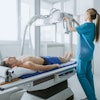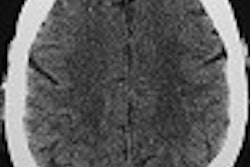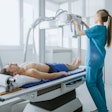The 2002 American Healthcare Radiology Administrators (AHRA) meeting in New Orleans from July 28-August 1 offered a broad spectrum of workshops and presentations on topics ranging from electronic imaging and technology to professional development to management and operations. In addition, more than 180 vendors displayed products and services to attendees in the Ernest N. Morial Convention Center exhibit hall.
Conference organizers stressed the importance of a multifaceted approach to management, emphasizing training, recruiting, retention, compliance, accounting, and contracts. Reflecting the current seller’s market in radiology staffing, breakout sessions looked at the ways in which institutions could improve employee retention.
Recruiting and retention
Shirley Pinette, manager of breast imaging and outpatient radiology at the Yale-New Haven Hospital in New Haven, CT, discussed a program to help employees move up the career ladder at her institution. Pinette noted that career-advancement programs could be important staff retention tools, giving employees opportunities to better themselves and contribute more to imaging facilities.
The current shortage of radiologic technologists is threatening to become a full-blown crisis as the general population grows gray and healthcare needs skyrocket. The CEO of the American Society of Radiologic Technologists (ASRT), Lynn May, outlined some of the projects his organization is working on in an effort to rebuild this dwindling segment of the imaging industry.
According to ASRT estimates, there are currently 212,000 radiographers in the U.S., including 44,000 mammographers and 12,000 MR technologists. Over the next 20 years, the aging baby boom population is expected to generate 48% more hospital visits. The total number of imaging exams will jump to 500 million annually, up from 350 million right now. As a result, the imaging community must come up with 75,000 more RTs in order to meet these healthcare demands.
The ASRT is proposing a three-pronged approach to staffing shortages. The society’s first effort is a recruiting and retention toolkit that offers guidance on setting up an RT scholarship program, becoming a clinical teaching site, writing job descriptions, and, most important, retaining employees. The organization also plans to revamp the current educational standards set for RTs. Under its new plan, x-ray technologists would have to earn at least an associate’s degree, while radiation therapists would be required to have a bachelor’s degree.
The ASRT also is calling for the creation of a new position, a radiology assistant (RA). The RA position would require a baccalaureate education. He or she would work under the supervision of the radiologist, concentrating on patient assessment, education, and care. They would have the ability to make initial image observations and report them to the radiologist.
Recruiting new employees doesn’t have to bust a facility’s budget. Rod Zapolski shared the recruitment strategy pursued by the University of Michigan Health System in Ann Arbor, MI.
"We don’t have a goal of compensating better than everyone else. We developed programs that focus on the employees and how we can get them to stay, as well as bring in new staff. As a result, our turnover and vacancy rates have been consistently low," said Zapolski, who is an assistant director in the department of radiology.
Personnel shortages, leaner budgets, and an increasing volume of exams are affecting not only the quality of care delivered to patients, but also the disposition of healthcare professionals. Retaining qualified caregivers is critical to the success of a facility, and employees who are satisfied with their workplace create a harmonious environment for both patients and fellow staff.
"When faced with dissatisfaction, the decision to wait it out, leave, or seek help comes from your ability to get past your personal feelings and reframe the dissatisfaction as a gift -- that is, an opportunity for you to learn," said Roberta Edge, director of imaging services at Doctors Medical Center in Modesto, CA, in a presentation on employee dissatisfaction.
Edge cautioned the administrators in the audience to be prepared to face unrealistic expectations from employees about the resolution of problems within their institution. "The expectation from staff is that things are going to get better overnight; however, in reality, change is slow and gradual," she said.
Compliance
On the compliance front, a pair of presentations shared successful strategies for coping with the Joint Commission on Accreditation of Healthcare Organizations (JCAHO), and with the U.S. Health Insurance Portability and Accountability Act (HIPAA).
Ginger Whitlock, a Chicago-based consultant who served as an associate director of the ambulatory accreditation program at JCAHO until May 2002, offered her insights to the accreditation process. "One of the most important things when getting ready for a survey is to know what the top troublesome standards were for the previous year," she explained.
Whitlock noted that imaging professionals must make the extra effort with surveyors to talk about their work. "The field of imaging and diagnostic radiology needs to be asking them more questions," she said. "Oftentimes, the joint commission surveyor doesn’t understand what you do and how the standards apply to that, so ... you’ll find yourself doing some educating of the surveyor."
For some administrators, just implementing HIPAA may feel like a fate worse than death. With a deadline fast approaching, making HIPAA a reality is crucial. During a presentation, James Keese, chief privacy officer for Eastman Kodak Health Imaging in Rochester, NY, offered some essential considerations for getting ready for HIPAA.
"Unlike Y2K, this is an ongoing opportunity for you to maintain compliance as well as change with the regulations as time goes on," Keese urged the audience. "It’s not just a one-time deal."
Metrics, contracts, and RFPs
Meeting the divergent demands of modern-day healthcare is a daunting task for radiology administrators faced with increasing demands and declining reimbursement. As a result, getting the most of available resources is critical to a facility’s success.
Performance metrics are a suite of tools that savvy managers can use to optimize business practices, identify areas of improvement, and assess the fiscal health of a company. In his presentation at the AHRA, Mel Allen of Siemens Medical Solutions in Mission, KS, outlined several steps that administrators can use to take the pulse of their practice.
Equipment downtime is anathema to imaging center administrators. A broken modality means patient rescheduling, professional staff standing around, and physicians left waiting for reports. With these realities in mind, a service contract from a modality manufacturer sounds like just the ticket, but James Guirsch, vice president of vendor relations with Brookfield, WI-based USCS Equipment Technology Solutions, cautioned attendees about signing on the dotted line.
"The most costly method of covering equipment repair costs is through an original equipment manufacturer (OEM) service contract," he said. He noted that the main drawback to maintenance contracts is that healthcare organizations relinquish internal control by giving the vendors complete control of the repair process.
The request for proposal (RFP) was examined as a strategic planning tool by a pair of presenters at the conference. It can be more than a dust-dry listing of specifications for a product or service destined for radiology. Crafted carefully, the RFP outlines a relationship between the vendor and the healthcare institution that enables each to prosper and thrive.
"The goal of a well-executed request for proposal is to create a process where both the customer and the service provider make informed, logical, and unemotional decisions that create a positive partnership," said David Coates, regional vice president of Shared PET Imaging of Canton, OH.
Coates, along with David Zanni, nuclear medicine systems operation manager at Columbus, OH-based Mount Carmel Healthcare System, presented their experience with the RFP process in creating a mobile PET service to attendees at the meeting.
Diplomacy, awards, and certification
Administrators may be called upon to exercise even more of their diplomatic muscle in coming years as other disciplines start to make inroads on some of the more lucrative imaging procedures. Georgann Bruski, manager of invasive cardiology at Beth Israel Deaconess Medical Center in Boston, and Sara Cutler, a principal at Advance Healthcare Consulting in Schenectady, NY, discussed their experiences in the radiology turf wars.
"Radiologists are admitting there are too many exams, too few (radiologists) to interpret them, and that they’re reading too much. Other specialties are using this as a justification to grab the procedures for themselves," said Bruski, who is a radiologic technologist as well as a former radiology department manager.
Bruski and Cutler advocated creating an interdisciplinary executive review team that would be charged with researching standards and determining what level was in the best interest of patient care. It would also jointly establish guidelines and protocols, develop a business plan, and craft a way for the various specialties to share revenue. Finally, the group would establish a quality assurance process to establish and monitor outcomes of the performed procedures.
The AHRA honored several of its members for their contributions in 2002. Vickie Bedel was named an AHRA fellow, Robert Bickford, Bradley Feltz, and Susan Thompson all received the organization's Osborne Scholarships; and the society’s President’s Award was bestowed on Monte Clinton and Henry "Sonny" Wallace for their contributions to the association.
The term of office for directors was extended from two to three years, and the board was reduced from 17 members to 13 in bylaw changes ratified by the membership at the meeting. The AHRA also voted to establish a radiology administration certification commission (RACC) to govern its certified radiology administrator (CRA) program. The RACC will be responsible for the examination and certification of CRA candidates.
The 2003 AHRA meeting will be held August 10-14 in Anaheim, CA.
AuntMinnie.com staff writer
September 9, 2002
Related Reading
Privacy specialist offers a methodical approach to HIPAA compliance, August 30, 2002
RFP can define scope, chart success of mobile PET, August 2, 2002
Multidisciplinary boards might calm radiology's raucous turf battles, August 1, 2002
University of Michigan trims employee turnover without breaking the bank, August 1, 2002
Employee dissatisfaction can lead to positive outcomes, July 31, 2002
JCAHO expert offers troubleshooting for accreditation review, July 31, 2002
Service-contract survival requires savvy negotiation, oversight, July 30, 2002
ASRT offers creative solutions to stem RT shortage, July 30, 2002
Motivational programs bolster employee retention, July 29, 2002
Performance metrics can help maximize investment returns, July 29, 2002
Copyright © 2002 AuntMinnie.com



















